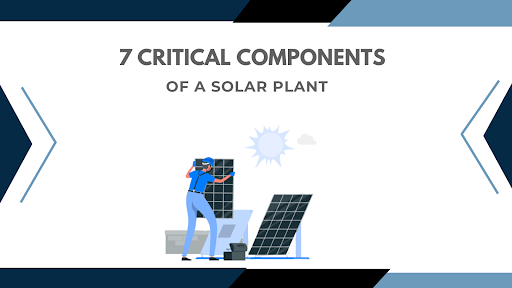
If you are a solar installation owner, you must be aware of all of its individual components and how they operate. This doesn’t just help in the day-to-day operation and maintenance of the solar plant, but also zero in on the troublesome parts in case of breakdowns. We at VEMC are one of the leading solar EPC based in Mumbai, and in this blog,
Explore the main components of your solar plant
7 parts of a solar plant
- Solar panels
- Inverter
- Model mounting structure (MMS)
- Optimizers
- Cables
- Energy monitoring
- Battery storage
Solar panels
Also known as solar modules, these generate electricity when the sun shines over them. Choosing the right type and number of panels is necessary to meet your requirements optimally. Solar panels must be cleaned and inspected regularly to ensure optimum performance and productivity.
Inverter
The solar panels produce Direct Current (DC) while your appliances run on Alternating Current (AC). It is the inverter that turns DC into AC to make the electric output usable. The inverter also keeps a check on the voltage flowing from the panels to your home or back to the grid.
Model mounting structure (MMS)
MMS is the most important part of your solar power infrastructure. A number of mounting structures are used depending on the type of surface you are installing the panels on. For instance, for low-slope roofs, ballasted MMS is used which uses a weighted tray to hold the panels in place. On the other hand, a ground-based solar installation uses an engineered MMS anchored in the ground.
Optimizers
As the name suggests, optimizers ensure the production of maximum power by the panels even if the surface has dirt, dust or shade. Optimizers are installed at the back of each solar panel. These also track the performance of the panels, thus assisting in troubleshooting. As soon as the system turns off, optimizers also automatically shut off power as a safety measure.
Cables
Your solar panel installation requires a robust network of cables to convey the current from the panels. These cables also interconnect the various components of the solar power system. Three main types of cables used in solar installations depending on their use are PV wires (mostly used for interconnection wiring), USE 2 wires (used in grounded solar panels), and THHN (used in wiring the buildings).
Energy monitoring
Energy monitoring is an important component of keeping track of your energy production versus consumption. The data on production and consumption monitoring helps keep tabs on the health, efficiency, and productivity of your solar power system.
Battery storage
Although not an essential component of your solar system, battery storage acts as a buffer. In times of electricity shortage or breakdown, battery storage works as a useful reservoir of energy. Batteries get conveniently and automatically recharged when the sun is shining on the panels.
Having comprehensive knowledge and understanding of your solar panel systems is important to keep track of how it is performing. To learn more about your solar power system components, you can get in touch with our experts at 022 43436655 or marketing@vemc.co.in. We at VEMC are the leading solar installation company based in Mumbai.

